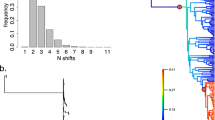Abstract
Quaternary climate change has been hypothesized to have played a significant role in driving diversification rates in a variety of taxa. We test the hypothesis of increased rates of diversification during the Quaternary in nine groups of New World bats (Chiroptera). The fit of six models of diversification was determined for each group. None experienced an increase in net diversification, rejecting the Quaternary hypothesis. Instead, four groups experienced constant net diversification rates, suggesting no Quaternary climate change impact. Five groups are evolving under a density-dependent model of diversification, suggesting climate cycles may have reduced rates initiated during the Pliocene or late Miocene. The distribution of divergences between sister taxa is consistent with results obtained from avian lineages experiencing declining rates of Quaternary diversification, further discrediting this often invoked hypothesis. Our results suggest that Quaternary climate change did not increase diversification rates in New World bats.


Similar content being viewed by others
References
Avise JC, Walker D (1999) Species realities and numbers in sexual vertebrates: perspectives from an asexually transmitted genome. Proc Natl Acad Sci USA 96:992–995
Barnosky A (2005) Effects of Quaternary climatic change on speciation in mammals. J Mammal Evol 12:247–264
Barrowclough GF, Zink RM (2009) Funds enough, and time: mtDNA, nuDNA and the discovery of divergence. Mol Ecol 18:2934–2936
Bradley RD, Baker RJ (2001) A test of the genetic species concept: cytochrome-b sequences and mammals. J Mammal 82:960–973
Cicero C, Johnson NK, Harrison R (2006) The tempo of avian diversification: reply. Evolution 60:413–414
Crisp MD, Cook LG (2009) Explosive radiation or cryptic mass extinction? Interpreting signatures in molecular phylogenies. Evolution 63:2257–2265
Drummond A, Rambaut A (2007) BEAST: Bayesian evolutionary analysis by sampling trees. Bmc Evol Biol 7:214
Drummond AJ, Ho SY, Phillips MJ, Rambaut A (2006) Relaxed phylogenetics and dating with confidence. Plos Biol 4:e88
Edwards SV, Beerli P (2000) Perspective: gene divergence, population divergence, and the variance in coalescence time in phylogeographic studies. Evolution 54:1839–1854
Edwards SV, Kingan SB, Calkins JD, Balakrishnan CN, Jennings WB, Swanson WJ, Sorenson MD (2005) Speciation in birds: genes, geography, and sexual selection. Proc Natl Acad Sci USA 102: 6550–6557
Gissi C, Reyes A, Pesole G, Saccone C (2000) Lineage-specific evolutionary rate in mammalian mtDNA. Mol Biol Evol 17:1022–1031
Irwin D, Kocher T, Wilson A (1991) Evolution of the cytochrome b gene of mammals. J Mol Evol 32:128–144
Klicka J, Zink RM (1997) The importance of recent ice ages in speciation: a failed paradigm. Science 277:1666–1669
Klicka J, Zink RM (1999) Pleistocene effects on North American songbird evolution. Proc R Soc of Lond B Biol Sci 266:695–700
Levinton JS (1979) A theory of diversity equilibrium and morphological evolution. Science 204:335–336
Lister AM (2004) The impact of Quaternary Ice Ages on mammalian evolution. Phil Trans R Soc Lond B Biol Sci 359:221–241
Lovette IJ (2005) Glacial cycles and the tempo of avian speciation. Trends Ecol Evol 20:57–59
Mayr E (1970) Populations, Species, and Evolution; an Abridgment of Animal Species and Evolution. Belknap Press of Harvard University Press, Cambridge
McPeek MA (2008) The ecological dynamics of clade diversification and community assembly. Am Nat 172:E270-284
Mengel RM (1964) The probable history of species formation in some northern wood warblers (Parulidae). Living Bird 3:9–43
Moritz C, Patton JL, Schneider CJ, Smith TB (2000) Diversification of rainforest faunas : an integrated molecular approach. ETATS-UNIS: Annual Reviews
Nee S (2006) Birth-death models in macroevolution. Annu Rev Ecol, Evol Syst 37:1–17
Phillimore AB, Price TD (2008) Density-dependent cladogenesis in birds. Plos Biol 6:e71
Posada D (2008) jModelTest: Phylogenetic Model Averaging. Mol Biol Evol 25:1253–1256
R Core Development Team (2007) R: A language and environment for statistical computing. R Foundation for Statistical Computing, Vienna
Rabosky DL (2006) Likelihood methods for detecting temporal shifts in diversification rates. Evolution 60:1152–1164
Rabosky DL, Lovette IJ (2008) Explosive evolutionary radiations: decreasing speciation or increasing extinction through time? Evolution 62:1866–1875
Rand AL (1948) Glaciation, an isolating factor in speciation. Evolution 2:314–321
Revell LJ, Harmon LJ, Glor RE (2005) Underparameterized model of sequence evolution leads to bias in the estimation of diversification rates from molecular phylogenies. Syst Biol 54:973–983
Rull V (2008) Speciation timing and neotropical biodiversity: the Tertiary-Quaternary debate in the light of molecular phylogenetic evidence. Mol Ecol 17:2722–2729
Stevens RD, Cox SB, Strauss RE, Willig MR (2003) Patterns of functional diversity across an extensive environmental gradient: vertebrate consumers, hidden treatments and latitudinal trends. Ecol Lett 6:1099–1108
Weir JT (2006) Divergent timing and patterns of species accumulation in lowlands and highland neotropical birds. Evolution 60:842–855
Weir JT, Schluter D (2004) Ice sheets promote speciation in boreal birds. Proc Biol Sci 271:1881–1887
Weir JT, Schluter D (2007) The latitudinal gradient in recent speciation and extinction rates of birds and mammals. Science 315:1574–1576
Zink RM, Barrowclough GF (2008) Mitochondrial DNA under siege in avian phylogeography. Mol Ecol 17:2107–2121
Zink RM, Slowinski JB (1995) Evidence from molecular systematics for decreased avian diversification in the Pleistocene Epoch. Proc Natl Acad Sci USA 92:5832–5835
Zink RM, Klicka J, Barber BR (2004) The tempo of avian diversification during the Quaternary. Phil Trans R Soc Lond B 359:215–219
Acknowledgments
We thank A. W. Jones, J. J. Johnson, P. B Berendzen, R. M. Zink, and two anonymous reviewers for comments. D. Rabosky provided assistance with LASER.
Author information
Authors and Affiliations
Corresponding author
Electronic supplementary material
Below is the link to the electronic supplementary material.
ESM 1
(PDF 4.59 mb)
Rights and permissions
About this article
Cite this article
Barber, B.R., Jensen, G. Quaternary Climate Change was Not an Engine of Diversification in New World Bats (Chiroptera). J Mammal Evol 19, 129–133 (2012). https://doi.org/10.1007/s10914-011-9180-z
Published:
Issue Date:
DOI: https://doi.org/10.1007/s10914-011-9180-z




